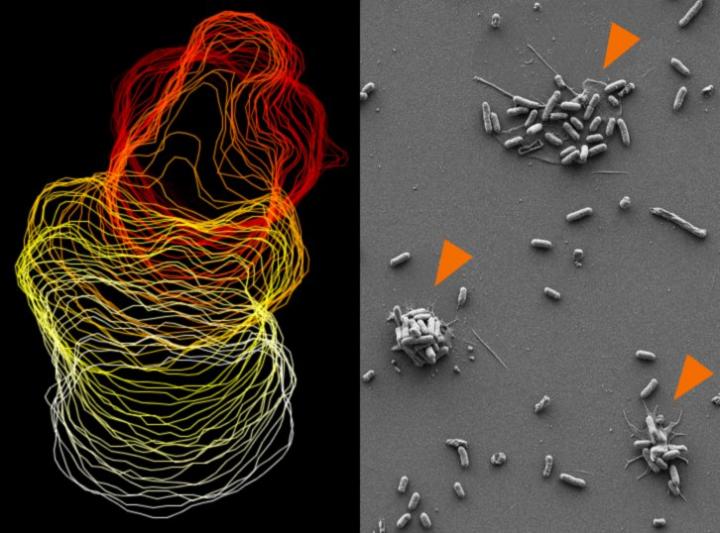The body's street sweepers

Left: Trajectory of a migrating platelet, depicted (from top to bottom) as a sequence of time-lapse images of the cell's outline. Right: As they migrate, platelets can collect bacteria into bundles (orange arrowheads). Credit: F. Gärtner/LMU
A new study by medical researchers at LMU extends the list of tasks performed by the smallest blood cells known as platelets: At sites of infection, actively migrating platelets sweep bacteria into aggregates for disposal by phagocytic cells.
The active role of blood platelets in immune defense has been underestimated. A new study now published by LMU medical researchers led by Dr. Florian Gärtner and Professor Steffen Massberg, shows that this cell type has a larger range of functions than previously thought. Thrombocytes are best known for their role in blood coagulation and wound-healing. But they are not only adept at patching up tears in the endothelial cell layer that lines the blood vessels.
“They are also important in defending the organism against bacterial pathogens. They have the capacity to actively migrate within the organism, to interact with pathogens and immobilize them.” This is lead author Florian Gärtner's summary of the major findings of a study that has just appeared in the leading journal Cell.
Some 750 billion platelets are passively transported in the bloodstream throughout the adult human body. Platelets adhere specifically to sites in the vasculature where the endothelial cells have been damaged by binding via surface receptors to proteins in the sub-endothelial cell layer.
They then spread out on the extracellular matrix, and interact with one another to form a network that acts like a sticking plaster to seal the wound. Furthermore, they are intimately involved in initiating blood coagulation at wound sites, but also in the development of blood clots (thromboses) which can obstruct blood circulation.
In a project carried out under the auspices of the DFG-funded Collaborative Research Center (Sonderforschungsbereich) SFB 914 (which focuses on the investigation of immune cell migration in inflammation, development and disease) Gärtner, Massberg and colleagues recently developed a way to track individual platelets at the site of an inflammatory reaction for extended periods. These observations revealed an unsuspected function of this cell type.
“Not only do they attach to bacterial cells by passively sticking to the vascular wall, they are also capable of active locomotion,” says Gärtner. At sites of inflammation or infection, platelets begin to actively explore their immediate environment, and when they come into contact with foreign bodies, such as invasive bacteria, they use the traction associated with locomotion to collect them into bundles, rather like street-sweepers clearing up debris. The resulting platelet-bacterial aggregates facilitate the activation of neutrophils, which engulf the trapped microbes.
The reason why the versatility of platelets has so far been overlooked may well lie in the fact that they are derived from giant precursor cells called megakaryocytes by fragmentation, and therefore lack nuclei. The work of Gärtner und Massberg demonstrates that they are nevertheless capable of undergoing dynamic shape change and active migration.
This finding has implications that extend beyond their role in immune defense, because it reveals what anucleate cells can do. “This is a very striking demonstration that the cytoskeletal apparatus responsible for cell motility does not depend on the presence of a nucleus,” Gärtner says.
In addition, the new results make platelets an attractive target for drug developers searching for novel ways to treat inflammation reactions. As Gärtner points out, “one way to modulate the action of the body's immune defenses would be to inhibit the ability of platelets to migrate.”
Media Contact
All latest news from the category: Life Sciences and Chemistry
Articles and reports from the Life Sciences and chemistry area deal with applied and basic research into modern biology, chemistry and human medicine.
Valuable information can be found on a range of life sciences fields including bacteriology, biochemistry, bionics, bioinformatics, biophysics, biotechnology, genetics, geobotany, human biology, marine biology, microbiology, molecular biology, cellular biology, zoology, bioinorganic chemistry, microchemistry and environmental chemistry.
Newest articles

A ‘language’ for ML models to predict nanopore properties
A large number of 2D materials like graphene can have nanopores – small holes formed by missing atoms through which foreign substances can pass. The properties of these nanopores dictate many…

Clinically validated, wearable ultrasound patch
… for continuous blood pressure monitoring. A team of researchers at the University of California San Diego has developed a new and improved wearable ultrasound patch for continuous and noninvasive…

A new puzzle piece for string theory research
Dr. Ksenia Fedosova from the Cluster of Excellence Mathematics Münster, along with an international research team, has proven a conjecture in string theory that physicists had proposed regarding certain equations….



